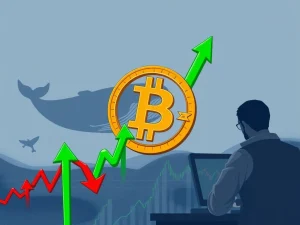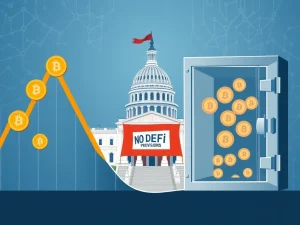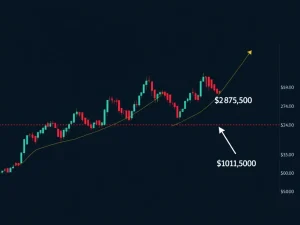Bitcoin September: Why BTC is Poised to Conquer ‘Red September’ for a Third Straight Year

For cryptocurrency investors, Bitcoin September has historically evoked caution. This month, infamously dubbed “Red September,” often sees Bitcoin (BTC) prices dip. However, recent trends suggest a powerful shift. Bitcoin is now poised to break this historical losing streak. It enters its third consecutive September with potential gains. This remarkable turnaround signals growing maturity in the crypto market trends and a robust outlook for the digital asset.
Decoding “Red September”: Bitcoin’s Historical Challenges
September historically represents Bitcoin’s weakest month. Data from 2013 to 2022 reveals an average monthly return of –3.77%. This period earned the dreaded nickname, “Red September.” China’s major crypto bans in 2017 and 2021 heavily influenced this negative record. Consequently, Bitcoin experienced six consecutive years of losses from 2017 to 2022. This pattern often mirrors traditional equities. September is also the weakest month for the S&P 500, as investors return from summer with a risk-off posture. They rebalance funds heading into the fourth quarter. Nevertheless, this gloom often proves temporary. September’s losses historically precede “Uptober.” October is Bitcoin’s second-best month after November. It has delivered gains in six consecutive years and only two losses throughout Bitcoin’s history, according to CoinGlass. This offers a glimmer of hope for Bitcoin September performance.
Regulatory Pressures and Market Shocks Shaped Past Red September Dips
Bitcoin’s early years saw scattered price action. It first breached $1,000 in 2013, attracting mainstream attention. Between 2013 and 2016, Bitcoin September performance was evenly split. It had two positive and two negative months. The trend dramatically shifted in 2017. During the initial coin offering (ICO) boom, Bitcoin crossed $1,000 and then $2,000. This speculative frenzy prompted China’s central bank to ban ICOs on September 4, 2017. This event sparked the first of six consecutive “Red Septembers.” South Korea followed with its own ICO ban later that month. Regulators worldwide issued warnings. This aftermath led to the first crypto winter, causing many ICO tokens to crash.
By September 2018, Bitcoin had dropped significantly. It fell from its December 2017 all-time high near $20,000 to below $7,000. A media report on September 5 claimed Goldman Sachs was abandoning its crypto desk plans. Although the bank later dismissed this as “fake news,” the report initially tanked Bitcoin. September 2019 brought another setback. The highly anticipated launch of Bakkt’s Bitcoin futures disappointed. Despite high expectations for institutional inflows, trading volumes were weak. This debut was branded a flop. Bitcoin plunged from near $10,000 to below $8,000 three days later. A Binance Research report cited Bakkt’s “disappointing start” as a contributing factor.
The next three Septembers reflected the pandemic era. COVID-19 initially boosted Bitcoin’s narrative as an inflation hedge. However, September 2020 saw capital rotate into Ether (ETH) during “DeFi Summer.” Ether’s dominance grew against Bitcoin, peaking that month. In September 2021, China struck again. They banned crypto mining and trading, further impacting the crypto market trends. The following year, the Terra/LUNA collapse in May left deep scars. September 2022 added to Bitcoin’s injury. The Federal Reserve delivered a 0.75 percentage point rate hike, its fifth in a year of seven hikes. These aggressive Federal Reserve Rate Cuts cycles deeply affected investor sentiment.
Key factors contributing to past “Red Septembers” include:
- Regulatory Bans: China’s prohibitions on ICOs, mining, and trading.
- Market Shocks: Events like the Bakkt launch flop and the Terra/LUNA collapse.
- Macroeconomic Headwinds: Aggressive interest rate hikes by the Federal Reserve.
Spot Bitcoin ETFs and Dovish Fed Remarks Ignite Optimism
Bitcoin finally broke its six-year “Red September” streak in 2023. A pivotal catalyst emerged on August 29. A federal appeals court ruled against the US Securities and Exchange Commission (SEC). It deemed the SEC’s rejection of Grayscale’s bid to convert its Bitcoin trust into a Spot Bitcoin ETF “arbitrary and capricious.” This decision forced regulators to revisit the application. It also revived confidence that a US spot Bitcoin ETF was inevitable. The ruling carried significant momentum into September. It helped Bitcoin climb about 4% that month. The US Federal Reserve also boosted sentiment. It held rates steady after 11 hikes in 12 meetings starting from March 2022.
Spot Bitcoin ETFs received approval and listed in the US in early 2024. By midyear, these financial instruments routinely posted billions of dollars in daily trading volume. Macroeconomic conditions further fueled this rally. The Fed delivered a rate cut on September 18, 2024. This marked the first cut since March 2020. This action signaled a shift in Federal Reserve Rate Cuts policy. Then, World Liberty Financial launched on September 16, 2024. It quickly became woven into US election narratives. Framed as a Donald Trump-aligned crypto venture, its debut during his successful presidential campaign signaled a political embrace of cryptocurrencies at the highest level. These developments painted a positive picture for crypto market trends.
Bitcoin September 2025: Poised for Continued Strength
Bitcoin September 2025 approaches with a stronger backdrop than previous downcycles. The month has long been a stumbling block. It was marked by regulatory shocks and tightening monetary policies. This year, the outlook appears significantly brighter. Spot Bitcoin ETFs continue to post billions in turnover. They have become a crucial gateway for institutional capital. Throughout 2025, struggling companies also turned to Bitcoin treasury strategies. They aimed to flip their misfortunes, indicating broader corporate adoption. The crypto industry also anticipates fresh speculation from China in August. Rumors suggest authorities could allow stablecoins pegged to the offshore yuan. However, officials have not yet confirmed these reports.
Investors’ attention remains squarely on the US. The Federal Reserve appears to have pivoted towards a more dovish stance. In late August, Fed Chair Jerome Powell delivered his final Jackson Hole speech. This symposium is a closely watched event in global economics. Fed chairs often use it to hint at policy direction. In 2022, Powell warned of “pain” for households and businesses during aggressive rate hikes. This year, he struck a dovish tone. He stated that a “shifting balance of risks” might warrant adjusting the Fed’s policy stance. Another reduction in Federal Reserve Rate Cuts is widely expected at the Federal Open Market Committee meeting scheduled for September 16-17. This macroeconomic support, coupled with robust institutional interest, positions Bitcoin favorably. It stands ready to potentially conquer “Red September” for the third consecutive year, reshaping long-term crypto market trends.










